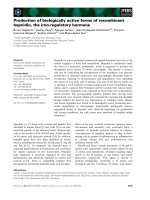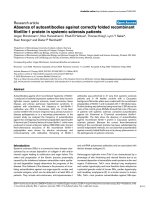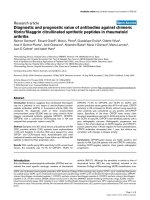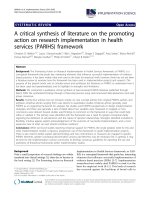Forms of resistance against the capitalist discipline female factory workers in batam
Bạn đang xem bản rút gọn của tài liệu. Xem và tải ngay bản đầy đủ của tài liệu tại đây (1.13 MB, 139 trang )
FORMS OF RESISTANCE AGAINST THE
CAPITALIST DISCIPLINE:
FEMALE FACTORY WORKERS IN BATAM
SITI NURAIDAH BT. ABDUL RAHMAN
(B.Soc.Sci. (Hons.), NUS
A THESIS SUBMITTED
FOR THE DEGREE OF MASTER OF
SOCIAL SCIENCES
DEPARTMENT OF SOCIOLOGY
NATIONAL UNIVERSITY OF SINGAPORE
2009
! "
$ % &
#
'
'
(
&
)
*
*
+
,
."
#
/ +
&
(
&
$
#
&
0
1
i
+
2
&
1
2
34
-
1
+
45
2
*
3
?
0
@
+
A
"
2
&
!
64
B
+
5
4
-
/
-
3?
*
4
3@
!
7
'
2
!
'
4+
839 : ;
0
<
63
*
=
-
*
6:
4*
C6
+
5
=
-
2
-
>#
C@
C9
ii
2
C4
#
*
?3
*
2
+
?C
?:
#
$
0
@6
#
4&
1
@?
2
2
?4
A6
+
5
#
/ #
*
7
5
7
#
=
!
2
A?
,
4"
-
&
:;
1
+
$
D
839 A@ 39 9 B<
&
/
:6
7
7
5
E#
:@
5
/ #
F
1
> E0
/ #
F
:B
BA
2
B:
iii
2
@4
+
G
"
2
7
B9
2
+
-
"
2
96
9A
7
/
"
&
$
D
9B
1
39 9 ;
1
2
A4
%
=
2
4
-
3; C
!
33?
2
&
33A
7
$
*
3; 3
*
&
3; ;
"
H
36;
36@
iv
&
+
*
.
/
+
4
/
.
/
+
0
-
>
I
v
-
#
H
&
G
&
G
'
G
/
H
vi
1
3 34 &
"
6 34 0
*
/ *
5
J
6A
*
839 9 ; 6; ; : <
6B
6 64 *
6C4+
6 ?4 *
/ =
!
/ #
6
,
6C
!
C 34 1
69
*
?C
=
? 34 2
B3
A 34 +
-
@ 34 #
33:
*
A 34 & ! 0
D
-
"
3; A
36;
+
6 34 =
5
6 64 +
6C4
@ 34 +
+
=
/ 0
39 A@ 9 :
39
8J 5 7 ! <
=
3:
39 9 3
39
9@
vii
Chapter 1: Introduction
Feminization of labour, gendered jobs and social change
Batam, an island of 415 sq km, is situated in the north-west of Indonesia.
Located about 21 km away from Singapore, it is approximately two-thirds the
size of its neighbour with a population of only 155,000 people (Royle, 1997).
This Singapore-Indonesian border zone became a centre of activity in the
early 1990s as both countries strengthened their bilateral ties, with Singapore
helping to direct western transnational corporation investments to Batam,
especially towards the manufacturing sector, at a time of rapid change in
Indonesia as it strove to modernize its economy, moving towards
industrialization. In exchange, Singapore retains an important role for its own
firms in the provision of management and administrative functions, as it has
been moving away from manufacturing towards the service industry.
1
Figure 1.1: Singapore and the Riau Islands (Grundy-Warr et al, 1999)
Batam‘s designation as a Free Trade Zone (FTZ) or Export Processing Zone
(EPZ) attracted TNC investments which created thousands of jobs as they set
up their factories in its industrial estates. Mack (2004) argues that in areas
legally cordoned off from the host nation, EPZs offer conditions which are
amenable to offshore investment and production, such as duty-free import of
2
parts and export of finished products, to structures that allow companies to
avoid restrictive labour legislation. EPZs treat ‗labour‘ as a generic component
and in their bid to attract investment, host countries may even restrict the
autonomy of workers by employing strict legislation against unionization.
Part of the marketed image of an EPZ rests on its ―docile‖ and
―nimble-fingered‖ female labourers, universally considered to be
more desirable employees than men. Generally recruited from
rural, agricultural backgrounds, these young (and usually
unmarried) women are classified as ―unskilled‖, and thus easily
replaceable.
(Mack, 2004: 157)
Why did the manufacturing of labour-intensive consumer goods pass into the
hands of developing countries in Asia? Also, how did feminization of labour
especially in the manufacturing sector of EPZs occur? The main argument
accounting for the proliferation of female factory workers is that they are a
source of cheap labour. This rests upon various assumptions: firstly, society is
organized upon the patriarchal order where men are seen to be the main
breadwinners. When women did enter formal employment, an unequal pay
structure was established according to the notion that men‘s wages must
support a family while wage-earning women are partly supported by men or at
least have only themselves to support. Secondly, the jobs that the women
entered are poorly compensated compared to the jobs that men entered as
women are seen to be doing work that is of a lower order, performing tasks
such as sewing, that they would have performed while maintaining the
household. Since traditionally women‘s household work was never valued
3
monetarily, similar work in the formal sector is poorly recompensed (Kaur,
1998). These arguments will be revisited and critiqued in later chapters.
The Argument in Brief
This thesis aims to deconstruct gender and sexuality with regard to female
migrant factory workers in Batam by acknowledging the discursive formation
of gender, which affects ‗doing gender‘ when dealing with the issue of women
and work. The thesis is largely centred on the theme of gendered work and
labour control. Firstly, based in a literature review, I summarize and argue that
the feminization of labour in Indonesia is facilitated by institutions at three
different levels: the state‘s ideology on labour as well as its discourse on
women, gendered recruitment practices at the factory level, as well as supply
factors that mobilize women that make them appealing towards employers as
ideal workers. In the above analysis, I take on the Foucauldian view that
‗discourse‘ produces its subjects, and also discuss how gendered subjects are
constructed relationally through discourse, where male and female workers
are produced relationally through a series of binary oppositions. To capture
this idea, I will illustrate how the Indonesian discourse on women, via the
kodrat filters affects the management discourse on recruitment practices. My
interviews with various factory managers show that the management
themselves have internalized taken-for-granted notions that there are certain
innate traits that women possess that make them ideal factory workers –
careful, disciplined, docile, diligent and embodying the tasks traditionally
4
carried out by women; as compared to men who are careless, lazy, and
undisciplined. What then are the implications of such stereotypes? Secondly, I
will highlight how these women, despite being stereotyped by their employers
as docile, empower themselves by employing various techniques of
resistance against the subordinating powers of the capitalist discipline. Such
techniques range from decreasing their productivity or declining to perform
overtime hours, to mass absenteeism, and lastly being on strike. How then do
these techniques relate to the women‘s autonomy and agency?
Methodology
I shall begin with a wide literature review of key works by various authors on
themes such as -- feminization of global manufacturing (Saptari, 2000; Kaur,
2004; Caraway, 2007), industrialization in Indonesia (Royle, 1997), gender
and migration (Chant & Radcliffe, 1992; Mahler & Pessar, 2006), female
migration in Indonesia (Hugo, 1992; Elmhirst, 2002), the construction of
feminine subjects in Indonesia (Sears, 1996; Tiwon, 1996; Devasahayam et
al, 2004) and also women and factory work in Indonesia (Ong, 1987; Wolf,
1992; Tjandraningsih, 2000; Mack, 2004; Ford & Lyons, 2006; Warouw, 2008;
Ford & Parker, 2008).
As part of my fieldwork, I conducted qualitative interviews with five
managers of five different factories on Batam, and posed them questions on
the development of Batam, the profile of their workers, as well as their hiring
5
policies, remuneration packages and the working conditions of their workers.
Their factories varied in terms of production, ranging from electronic products
such as semiconductors and television tuners to garments and also checking
finished products for quality control. My informants told me that a high
proportion of their workers, almost 80 per cent of their production operators,
are females. Managers also revealed that their workers may sometimes show
signs of dissatisfaction with the management, mainly due to salary issues.
These issues will be further discussed in my paper.
Interviews were also conducted with several female factory workers in
the same factory, PT Permata, a Japanese firm which manufactures hard
disks for electronic devices, PT Permata and themes centred upon their
migratory experience and dormitory life emerged.
Theoretical Apparatus
One of the first issues when considering the topic is to deconstruct gender
and gender identity with regards to work and labour control. Mahler & Pessar
(2006) offers a very succinct definition of approaching gender as a subject
under scrutiny:
Gender is the meaning people give to the biological reality that there
are two sexes. It is a human intervention that organizes our behaviour
and thought, not as a set of static structures or roles but as an
ongoing process. People do ―gender work‖; through practices and
discourses they negotiate relationships and conflicting interests.
Conceptualizing gender as a process yields a more praxis-oriented
6
perspective wherein gender identities, relations, and ideologies are
fluid, not fixed.
(Mahler & Passer, 2006: 29)
Therefore, in relation to my research topic, an omnipresent fact of industrial
life is the categorization of jobs in factories as ―men‘s work‖ and ―women‘s
work‖, since men and women seldom do the same jobs. Often, the literature
suggests that such profound gender segregation is rooted in the gendered
discourse of work. This research is guided by Caraway‘s (2007) conception of
‗gendered discourses of work‘. Caraway argues that ‗the gendered worker on
the shop floor is created in part through the discourses produced by the
management about gendered workers‘.
From a Foucauldian perspective the issue is not whether the women
are patient, disciplined, and diligent but that the subject of the woman
worker as patient, disciplined, and diligent worker is produced
through discourse.
(Caraway, 2007: 30)
Post-structural feminists have called for special attention to be paid to how
gendered
subjects
are
created
relationally
through
discourse:
the
dichotomous relations between male and female workers. This view is
reproduced several times in most of the works that I reviewed on women and
factory work. Therefore, this research is very much guided by Caraway‘s tool
of inquiry, where she adopted a ‗syncretic conceptualization of gendered
discourses of work‘ combining Foucault‘s (1990) conception of discourse and
Connell‘s (1987) praxis-oriented perspective and poststructuralist feminist
approaches.
7
Research Findings and Plan of the Thesis
Chapter 2 attunes the reader to the historical emergence of Indonesia‘s export
oriented industrialization strategy and how this has affected labour patterns.
Indonesia was described in the 1960s as being one of the least industrialized
countries in the world for its size (Hill, 1990) and the manufacturing sector
only totalled an estimate of 840,000 workers in 1971. During the 1980s,
however, due to trade liberalization and deregulation policies, Indonesia
moved from being a negligible exporter of manufactures to a significant
supplier. Statistics show that in 1980, manufactures generated less than 3
percent of total exports; however by 1992 they were nearly 50 percent (Hill,
1996:810). This expansion was facilitated by a series of trade reforms, during
the New Order years of 1966 to 1997/8. Indonesia moved away from a
protectionist strategy of protecting its domestic market and towards an export
oriented industrialization (EOI) strategy as the country, which is a major oil
exporter, coped with the collapse of the price of oil. This chapter highlights
Indonesia‘s rise as an export manufacturer and the concomitant effects on the
changes in labour structure i.e. – the feminization of labour and its resultant
effects, such as the patterns of migration and concerns on exploitative nature
of female factory work.
This chapter also later highlights how Batam features as part of
Indonesia‘s strategy to attract an inflow of large foreign direct investment
8
(FDI) as an export processing zone (or also called ‗bonded zone‘ by
commentators on the Indonesian economy) in order to leverage on its
comparative advantage in export manufacturing. Since this research is largely
centred on themes of gendered work and labour control, this chapter also
reviews the feminist literature on women‘s work in export processing zones
and highlights the waves of feminization of the manufacturing industry as
posited by Caraway (2007).
Chapters 3, 4, and 5 turn attention to an in-depth analysis of the case
in point, Batam, specifically on, BatamIndo Industrial Park. Chapter 3 outlines
the profile of factory workers in the manufacturing sector, who are mostly
young, single females, between the ages of 18-22. Based on my in-depth field
interviews with the women, they relate to me their migratory experience and
the anxieties that they face as well as how they cope with and mitigate these
anxieties. I argue that based on the everyday experiences that these women
share as a community of migrant workers, it allows them to create and share a
‗structure of feeling‘ where they create their own identity via their own feelings
and emotions. Examples of such feelings are bareng (togetherness),
kebebasan (freedom) and kangen (homesickness) and these women cope
with these anxieties by being each other‘s social support system.
Chapter 4 demonstrates the importance of bringing gender to the core
and not to fall simply into the trap of tokenism when discussing gender by
simply inserting sex as a variable. The understanding of the Foucauldian
9
concept of the gendered discourses of work is introduced to show how this
leads to gendered outcomes, as again portrayed by Caraway, as this is
pivotal towards the understanding of women and labour in factories.
Therefore, before we can see the effects of industrialization on work and
labour control, we must firstly explore the very operation of gender and
explore how it is articulated with other axes of differentiation in complex ways.
I argue that the stereotypical, gendered image of the nimble-fingered, docile
female worker is articulated at different levels, Firstly, the ideological level of
the state‘s discourse on gender via the notion of kodrat wanita (women‘s
nature). This section will highlight the Indonesian discourse on gender as
posited by scholars such as Suryakusuma (1987), Blackwood (1995), Tiwon
(1996), Wieringa (2003) and Caraway (2007). The next level where the
construction of the ideal female factory worker is articulated is at the level of
recruitment practices by the management. Management believes that women
possess certain characteristics that make them better workers at certain tasks
than men. Therefore, in order to understand employers‘ preference to employ
women as production operators in their factories, we must consider the
gendered discourses of work. I take on the view that ‗discourse‘ (Foucault,
1990) produces its subjects, and also discuss how gendered subjects are
constructed relationally through discourse, where male and female workers
are produced relationally through a series of binary oppositions (Caraway,
2007). To capture this idea, my interviews with various factory managers
show that they have internalized as a fact that there are certain innate traits
that women possess that make them ideal factory workers – careful,
10
disciplined, docile and diligent, embodying the tasks traditionally carried out
by women; as compared to men who are careless, lazy, and undisciplined.
Lastly, the process of feminization in Indonesia finally took off in the 1980s
onwards due to the increased supply of labour – the availability of qualified,
educated female labour, attributed mostly to the New Order education policies
which improved the educational levels of women. All the above factors
contributed significantly to the process of feminization in Indonesia between
the years 1971 to 1994, the percentage of women involved in manufacturing
work increased substantially from 37 per cent to 51 per cent (Caraway, 2007).
Chapter 5 centres the issue of resistance in relation or in tension with
the agency of the feminine subject. Here, I conceptualize the definition of
resistance, aided by Hollander and Einwohner‘s typology of resistance. In
order for resistance to manifest itself, there must be binary oppositions, and in
my research, the struggle between the capitalists (manager) and labour
(production operators) is not only a class issue but also has a gendered
dimension. I argue that the capitalism, is a ‗disciplinary practice‘ where
capitalists assert their repressive power in order to demand compliance from
the labouring subject (Sakolsky, 1992). In the factories, the disciplinary
practice is asserted via Taylorism, the scientific management of work, which
includes the adherence towards standard operating protocol as well as Key
Performance Indicators (KPIs) to monitor productivity. These are employed in
order to obtain the maximum surplus-value from the employment of labour. As
an extension of obtaining maximum surplus value from the labourer, the
11
production operators are paid only the minimum wage of 1,080,000rp
(US$106.40). Further, when the work order increases, the factory increases
its output by imposing compulsory overtime hours on its staff, since their
production operators are single women who do not have a family to return to
and hence usually available to perform overtime. Therefore, subjected the
capitalist discipline, dissatisfaction amongst the female factory workers arise.
From my interviews with the factory managers and factory workers,
they highlight that there are four different forms of female labour resistance
that may be enacted in succession: (1) production slowdown, (2) refusal to
perform overtime hours, (3) mass absenteeism and lastly (4) labour strike.
This chapter illustrates how resistance is translated into practice which argues
for the significant agency of the female factory worker by highlighting the
inherent contradiction in the logic of the resistance posed by these women. I
shall show with evidence from other researchers as well as my own findings
from my research site that employers are keen to employ women as
production operators because they are believed to be the ideal workforce;
docile and disciplined. How then do factory managers account for these
displays of overt resistance by the women? What is not discussed in this
section is how the workers themselves conceptualise their acts of resistance,
since firstly, interviews with the managers were intended to uncover the role
of managerial practice in the construction of a gendered workplace, and
secondly, I did not have access to informants who were involved in the sites of
resistance.
12
Chapter 6 concludes the thesis and ponders on the future directions of
research with regard to issues concerning female factory workers in Batam.
One of the interesting issues is the rise of labour organizations such as the
FSPMI (Indonesian Metal Workers‘ Union) and Lomenik SPSI (Federation of
Metal, Machine and Electronics) in representing the rights of the workers.
Directions for future research may involve to noting the development of labour
movements in Batam in their campaign against precarious work. What seems
to be happening on the ground as a concomitant effect of the feminization of
the workforce is the feminization of unions. Questions include, what does the
feminization of unions mean and what are its projected future consequences?
13
Chapter 2: Industrialization in Indonesia
Framing the Global Factory: Indonesia‘s trajectory towards industrialization
and the feminization of labour
Women‘s labour force participation has increased dramatically in developing
countries like Indonesia over the past several decades. While the proportion
of employed women is still lower than in more developed countries, recent
estimates indicated that labour force participation rates among women ages
20 to 54 exceed 60 percent in developing countries as a whole. According to
information from the International Labour Organization (ILO), women‘s
employment has increased faster than men‘s employment since 1980 in most
regions of the world (Appleyard, 1999). Villareal and Yu (2007) argue that
factors such as women‘s higher educational attainment and lower fertility rate,
as well as changing attitudes toward women working outside the home, raise
female employment rates by increasing the demand for female workers in the
manufacturing sector.
This increase is female labour force participation is especially
pronounced in developing countries which embrace export oriented
industrialization with a focus on the manufacturing industry, such as the four
Asian tigers, Singapore, Hong Kong, Taiwan and South Korea and other
developing countries like Brazil, Indonesia, Malaysia and Thailand. Kaur
14
(2004) attributes the shift of manufacturing labour-intensive consumer goods
from the developed to the developing countries to a global restructuring for
manufacturing. Increased global competition resulted in the industry in the
United States, Europe and Japan ‗reassembling‘ itself to reduce costs while
remaining competitive.1
Therefore, in order to understand globalization and women‘s
employment in developing countries like Indonesia, it is important to attune
ourselves to the historical emergence of the export oriented industrialization
strategy and how this has affected labour patterns. The political context of its
emergence is also important as this elucidates the relationship between the
state, labour and civil society.
Becoming an exporter of manufactures: the case of Indonesia
Indonesia was described in the 1960s as being one of the least industrialized
countries in the world for its size (Hill, 1990) and the manufacturing sector
only totalled an estimate of 840,000 workers in 1971. During the 1980s,
however, due to trade liberalization and deregulation policies, Indonesia
moved from being a negligible exporter of manufactures to a significant
supplier. Statistics show that in 1980, manufactures generated less than 3
percent of total exports; however by 1992 they were nearly 50 percent (Hill,
1996:810). This expansion was facilitated by a series of trade reforms as
1
For a more detailed discussion, refer to Gills & Piper (2002), Kaur (2004) and Caraway (2007).
15
Indonesia – a major oil exporter – coped with the collapse of the price of oil.
This present section highlights Indonesia‘s rise as an export manufacturer and
the concomitant effects on the changes in labour structure i.e. – the
feminization of labour and its resultant effects, such as the patterns of
migration and concerns on exploitative nature of female factory work.
The 1980s trade reforms have already been very well documented by
other writers but it is imperative that a brief introduction is given to provide a
background understanding, highlighting industrial change in Indonesia.
Successful economic policy in Indonesia is always traced back to the
years of 1966 to 1997/8. During New Order rule, under the presidency of
Suharto, the Indonesian economy experienced rapid and sustained growth,
which enabled Indonesia to rise up the ranks from one of the poorest
countries in the mid-1960s to one of the eight high-performing Asian
economies in the early 1990s, along with Japan and the four Asian Tigers-Singapore, Hong Kong, Taiwan, South Korea - as well as Indonesia‘s
neighbours Malaysia and Thailand.
The rapid economic growth during the period 1965 to 1997 was driven
mostly by the expansion of three main sectors of the economy—agriculture,
manufacturing and services. However, it was the manufacturing sector
throughout this period which was growing at double digits, much faster than
the other two sectors which were growing at single digits. The average growth
16
rate during this period, as highlighted in table 2.1 below averaged at about 7.0
percent.
Table 2.1: Economic Growth and Transformation in Indonesia, 1965-97
Source: Thee, 2006:343
In the late 1960s and the early 1970s, Indonesia‘s rapid industrial
growth was fuelled by the liberalization of economic policies which also
marked its return to normal economic conditions after the political turmoil and
economic chaos of the early 1960s, a remnant of the Sukarno years.
Up to the late 1970s, the growth of the Indonesian economy was based
primarily on its exports of crude oil. It was during this oil boom period that the
Indonesian economy was able to sustain protectionist import-substituting
policies. The de facto Indonesian Minister of Industry, B. J. Habibie, rejected
free market solutions and opted for industrialization via import substitution
(ISI). ISI is based on production for the local market and involves high levels
of protection for domestic producers. As was the case with other South-East
Asian countries, ISI did not achieve the results expected, partly due to the fact
17









